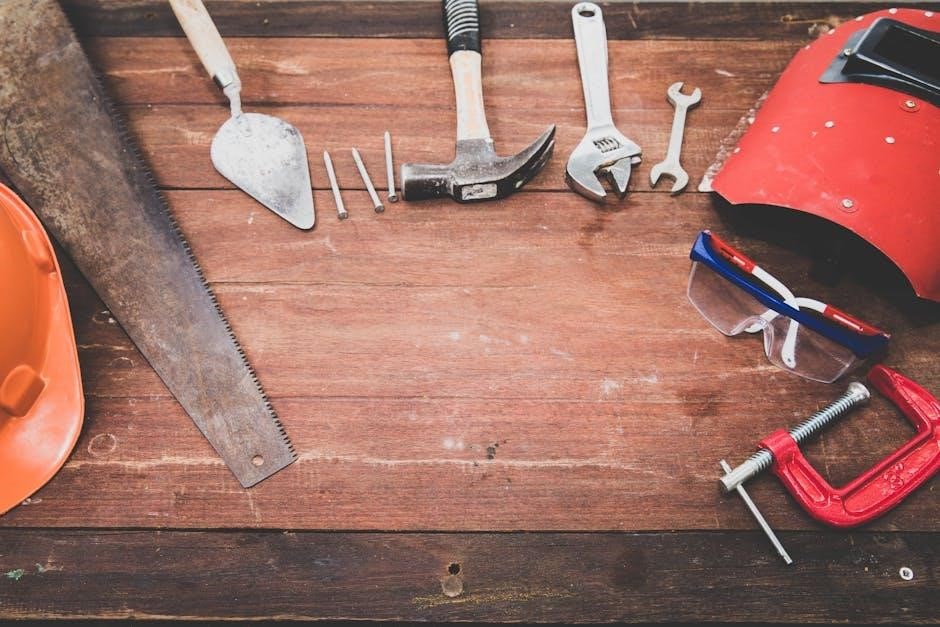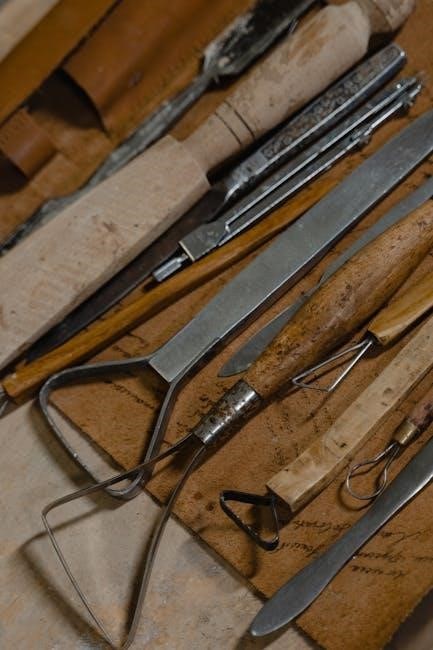Chisel honing guides are essential tools for maintaining sharpness and precision․ They help achieve precise angles, ensure consistency, and are versatile for various woodworking tools․
What is a Chisel Honing Guide?
A chisel honing guide is a specialized tool designed to help woodworkers sharpen chisels and plane irons with precision․ It ensures the blade is held at the correct angle and maintains consistency during the sharpening process․ The guide typically consists of a clamp or holder for the chisel and adjustable settings to control the sharpening angle․ By securing the chisel in place, it prevents wobbling and allows for even contact with the sharpening stone․ This tool is particularly useful for achieving straight, smooth edges and maintaining the integrity of the chisel’s bevel․ It is an indispensable aid for both novice and experienced woodworkers, offering a reliable method to hone tools to their optimal sharpness․
Importance of Using a Honing Guide for Chisels
Using a honing guide for chisels is crucial for achieving precise, consistent results․ It ensures the blade is sharpened at the correct angle, preventing uneven edges and extending tool life․ The guide helps maintain sharpness, which is essential for clean cuts and efficient woodworking․ For novices, it simplifies the sharpening process, while experienced woodworkers appreciate its reliability․ A honing guide also reduces the need for costly tools, making it a practical investment․ Regular use ensures tools remain in optimal condition, enhancing overall woodworking quality and productivity․ By maintaining sharpness, it reduces fatigue and improves safety, making it an indispensable tool for any workshop․

Understanding the Components of a Chisel Honing Guide
A chisel honing guide typically includes a base, clamping mechanism, and angle adjustment knobs․ These components work together to securely hold the chisel and maintain precise alignment during sharpening․

Key Parts of the Honing Guide
A chisel honing guide consists of several critical components․ The base provides stability, while the clamping mechanism securely holds the chisel in place․ Adjustable angle knobs allow for precise angle setting, ensuring consistency․ Rollers or glide systems enable smooth movement across the sharpening stone․ Some guides also feature digital angle gauges for added accuracy․ These parts work together to maintain proper alignment and control during the sharpening process, making it easier to achieve a sharp, even edge․ Properly functioning components ensure efficient and effective sharpening, making the honing guide an indispensable tool for woodworkers․
How the Guide Ensures Accuracy and Consistency
The honing guide ensures accuracy and consistency by maintaining precise control over the sharpening angle and edge alignment․ Its rigid frame prevents the chisel from shifting during sharpening, while adjustable settings allow for consistent results․ The guide’s rollers or glide system facilitate smooth, even strokes across the sharpening stone, eliminating uneven wear․ This level of control is particularly beneficial for maintaining uniform bevels, which are crucial for optimal tool performance․ By minimizing human error, the guide consistently delivers sharp, precise edges, making it an invaluable asset for woodworkers seeking professional-grade results․ This consistency ensures tools remain reliable and effective, enhancing overall woodworking efficiency and quality․

Step-by-Step Guide to Using a Chisel Honing Guide
Insert the chisel into the guide, set the desired angle, and tighten․ Apply oil to the stone, then sharpen by moving the guide smoothly back and forth․
Preparing the Chisel and Honing Guide
Insert the chisel into the honing guide with the bevel facing down․ Tighten the guide just enough to hold the chisel securely, leaving it loose enough for minor adjustments․ Ensure the entire bevel makes contact with the sharpening surface․ Apply a few drops of oil to the oilstone to reduce friction and prevent overheating․ Place the guide on a flat, stable surface, such as a workbench, and position the chisel at the desired angle․ Double-check that the bevel is aligned correctly and the edge is square to the stone․ This setup ensures precise control and even sharpening․

Setting the Correct Angle for Sharpening
Setting the correct angle is crucial for effective sharpening․ Most chisels are sharpened between 25° and 35°, with 30° being a common starting point․ Use a digital angle guide or bevel gauge to ensure accuracy․ Align the chisel in the honing guide and adjust the mechanism until the desired angle is achieved․ For precise results, use a set-up block or reference tool․ Lightly tighten the guide to secure the angle․ If no angle guide is available, estimate by aligning the bevel parallel to the stone edge at the chosen angle․ Proper alignment ensures a sharp, durable edge․ Always double-check the angle before sharpening to avoid unnecessary adjustments․ This step is key to achieving optimal sharpness and tool performance․

Sharpening the Chisel Using the Guide
Sharpening a chisel with a honing guide involves precise, controlled strokes․ Apply oil to the sharpening stone to reduce friction and prevent overheating․ Insert the chisel into the guide, ensuring it is securely held at the desired angle․ With light to moderate pressure, push and pull the chisel across the stone in smooth, even strokes․ Repeat this process approximately 10 times, flipping the chisel to sharpen both sides․ Maintain consistent pressure to avoid uneven wear․ Periodically inspect the edge to check progress․ Continue until the chisel achieves a razor-sharp edge․ For optimal results, work through progressively finer stones to refine the edge․ Always keep the guide aligned and the chisel stable during sharpening․
Final Touches and Inspection
After sharpening, inspect the chisel’s edge for straightness and sharpness․ Use a magnifying glass to check for any remaining imperfections․ Lightly hone the edge with a steel or fine stone to remove micro-scratches․ Wipe the chisel clean with a cloth to remove any metal particles or oil residue․ Store the chisel in a dry place, preferably in a protective sleeve, to prevent rust or accidental dulling․ Regular inspection ensures the edge remains sharp and ready for use․ Proper maintenance extends the chisel’s lifespan and maintains its performance․ Always verify the edge’s alignment and sharpness before returning the chisel to your toolbox․

Tips for Maintaining Your Chisel Honing Guide

Regularly clean and oil moving parts to prevent rust․ Check for squareness and tighten components as needed․ Store in a dry place to ensure longevity and performance․
Cleaning and Storage
Proper cleaning and storage are crucial for maintaining your chisel honing guide․ After use, wipe the guide with a soft cloth to remove any metal shavings or debris․ For more thorough cleaning, use mild soap and water, ensuring all parts are rinsed and dried thoroughly to prevent rust․ Store the guide in a dry, cool place, away from direct sunlight․ Avoid exposing it to harsh chemicals or abrasive materials, as this can damage the finish or components․ Regularly inspect the guide for squareness and tighten any loose parts․ Lightly oil moving components to maintain smooth operation․ Proper care ensures longevity and optimal performance of your honing guide․
Troubleshooting Common Issues
Common issues with chisel honing guides often relate to alignment or improper setup․ If the guide does not hold the chisel securely, check that it is tightened evenly and not over-tightened, which can cause misalignment․ For uneven sharpening, ensure the guide is set to the correct angle and that the chisel is parallel to the sharpening stone․ If the edge becomes uneven, inspect the guide for squareness and adjust as needed․ Lightly oil moving parts if they feel stiff․ Regularly clean the guide to remove metal shavings that may interfere with its performance․ Proper adjustment and maintenance can resolve most issues, ensuring accurate and consistent sharpening results․

Chisel honing guides are invaluable for achieving precise angles and consistency in sharpening․ They enhance the quality of woodworking projects and ensure tools remain in optimal condition․
Why Every Woodworker Should Use a Chisel Honing Guide
A chisel honing guide is an indispensable tool for woodworkers, ensuring sharp, precise edges consistently․ It eliminates guesswork, helping beginners and pros achieve professional results․ By maintaining perfect angles and straight edges, it prevents tools from becoming uneven or dull quickly․ This guide enhances the quality of cuts, reduces waste, and prolongs tool life․ Its versatility allows sharpening of various chisels and plane irons, making it a must-have for any workshop․ With a honing guide, woodworkers can achieve superior sharpness effortlessly, saving time and improving overall craftsmanship․
